chap010Prospective Analysis(财务报表分析,台湾中兴大学)
- 格式:ppt
- 大小:243.00 KB
- 文档页数:18
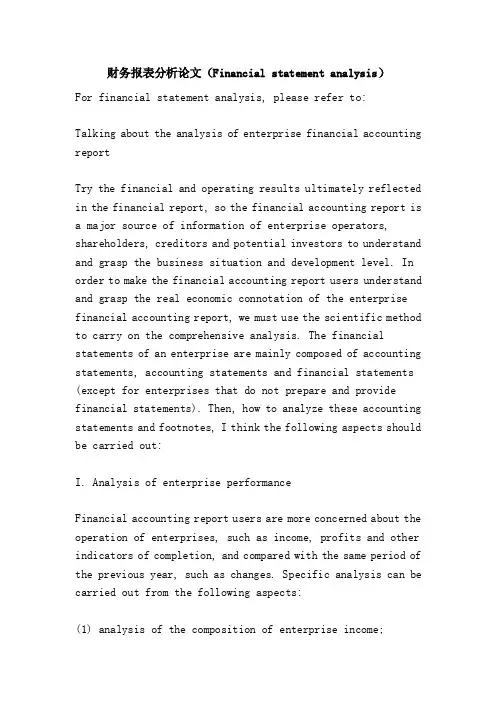
财务报表分析论文(Financial statement analysis)For financial statement analysis, please refer to:Talking about the analysis of enterprise financial accounting reportTry the financial and operating results ultimately reflected in the financial report, so the financial accounting report is a major source of information of enterprise operators, shareholders, creditors and potential investors to understand and grasp the business situation and development level. In order to make the financial accounting report users understand and grasp the real economic connotation of the enterprise financial accounting report, we must use the scientific method to carry on the comprehensive analysis. The financial statements of an enterprise are mainly composed of accounting statements, accounting statements and financial statements (except for enterprises that do not prepare and provide financial statements). Then, how to analyze these accounting statements and footnotes, I think the following aspects should be carried out:I. Analysis of enterprise performanceFinancial accounting report users are more concerned about the operation of enterprises, such as income, profits and other indicators of completion, and compared with the same period of the previous year, such as changes. Specific analysis can be carried out from the following aspects:(1) analysis of the composition of enterprise income;The income of the enterprise mainly includes the main business income and other business income. Among them, the main business income is the most important corporate income indicators, the analysis of the indicators, you can use the current income compared with the same period of the previous year, the general use of the last three years of data as well. In the main business income analysis process, we must pay attention to the proportion of revenue items in the total amount of revenue, in order to understand the main business of enterprises in the same industry status and development prospects. The main business income shall have an absolute share of the total revenue of the enterprise, otherwise, the enterprise shall be deemed to be in an abnormal economic condition or whose main business is not outstanding.(two) analyzing the profitability of enterprisesProfit index is one of the most important indicators of economic benefits. Through the analysis of this index, we can understand the level of profitability and development prospects of enterprises. We can also evaluate the stability of enterprise profit sources by observing the share of operating profit, investment income, subsidy income and out of business net income in total profits of enterprises.(three) analyze the influence of cost and expense on enterprise profitCost is an important factor affecting business profits. Under the condition of certain income, the lower the cost, the greaterthe profits of the enterprise, and vice versa. This can be verified by selling profit margins or cost margins. At the same time, the need for further decomposition of the cost, in order to understand the project cost proportion, so that managers can effectively compress the expenses to get the maximum output with minimum input.Two, asset management efficiency analysisFor enterprises, the operation ability of each asset reflects the management level and efficiency of the existing assets. The higher the efficiency of the use of assets, the faster the turnover, reflecting the better liquidity of assets, the ability to repay debt is stronger, the assets of enterprises have been fully utilized. Analysis on the efficiency of asset management, mainly through the following indicators, namely, accounts receivable turnover, inventory turnover rate, investment return rate, turnover rate of fixed assets and current assets turnover and total asset turnover.Accounts receivable turnover rate, usually by aging analysis method, the key analysis should be the quality status of accounts receivable, evaluate the rationality of accounting method for the loss of bad debts, bad debts and bad debts, but also a concrete analysis of its causes.Analysis of inventory turnover, mainly to the index with the same industry and enterprises before the year is compared, but also affect the inventory turnover rate of individual factors for further analysis, such as raw materials, semi-finished products, finished goods inventory turnover, in order to findout the root cause of the level of inventory turnover.The analysis of the return on investment mainly depends on the period of investment and the payback period of investment, so as to know whether the investment of an enterprise is effective and how much the degree of investment risk is.The analysis of the turnover ratio of the three major assets (liquid assets, fixed assets and total assets) mainly depends on the efficiency of the use of assets and whether there is any bad assets.Three, solvency analysisSolvency is the ability of an enterprise to pay its due debts, including the ability to repay short-term and long-term debt. Debt paying ability is the most concern of creditors. In view of the safety of enterprises, more and more attention has been paid to shareholders and investors. The solvency of an enterprise is mainly through liquidity ratio, quick ratio, asset liability ratio, shareholder equity ratio and interest protection multiple.1. generally, the liquidity ratio is 2, which is ideal. But there are different requirements for different industries,For non productive enterprises, liquidity is mainly cash and liquidity receivable due to less inventory. Its low liquidity ratio is also reasonable.2. generally speaking, the quick ratio is more suitable for 1.However, due to the possibility of longer accounts receivable in current assets, the actual solvency of an enterprise will be affected. In order to make up for the limitations of this ratio, the objective evaluation of the solvency of an enterprise can also be assessed by using an overspeed ratio. The index is to use the company's quick assets, that is, monetary funds, short-term securities, notes receivable and the reputation of the customer's accounts receivable to reflect and measure the liquidity of enterprises and short-term solvency. The index because of the important factors removed has nothing to do with the cash flow such as prepaid expenses and the impact of the quick ratio of credibility as credibility is not high customer accounts receivable, therefore, to objectively evaluate the firm's liquidity and short-term debt paying ability.3. generally speaking, the asset liability ratio is 60%, more appropriate. The ratio is too low, indicating that the enterprises do not have a strong sense of debt management, the ratio is too high, and the financial risk of enterprises is too great.4., for the shareholder equity ratio, the index value is large, indicating the high risk of financial structure, the protection of the interests of creditors is lower; and the value of this index is small, is a low-risk financial structure.5. what is the surplus of interest paid by the interest guarantee times?. The higher the value of the index, the smaller the business risk, the greater the ability to repay the debt.Four. Cash flow analysisThe cash flow statement is used to reflect the firm's ability to create net cash flows. The analysis of the cash flow statement, due to information and help users to understand the changes in statements of enterprises in a certain period of cash inflow and outflow, forecast future cash flow during the evaluation of enterprise financial structure and ability to repay the debts, determine the enterprise to adapt to external environment changes, adjust the room for cash payments, to reveal the relationship between enterprises the level of profitability and cash flow. Since the objectivity of cash flow is related to other indicators, the analysis of cash flow can be a good complement to other indicators.1. cash flow and sales income ratio. The ratio represents the cash flow earned for each one yuan sales income. The higher the ratio, the better the effect of cash flow, the stronger the ability to pay.2. cash flow and operating profit ratio. The ratio represents the cash flow earned for each one yuan operating profit. The higher the ratio, the higher the quality of the business is, the more profits the company will make in cash.3. net cash flow to net profit ratio. The ratio shows the amount of net cash inflow from operating activities in each net profit realized, reflecting the level of the net profit of the enterprise and the ability of the enterprise to pay dividends.4. cash flow rate of return on assets. The ratio reflects thecash flow per dollar of assets. The higher the ratio, the higher the efficiency of the use of assets.5. debt to cash ratio, the ratio of net cash flows from operating activities to average current liabilities. Because the profit year does not necessarily have enough cash to repay the debt, so the implementation of debt cash flow index system based on the use of cash, can fully reflect the business activities generated net cash inflow to what extent can guarantee the payment of current liabilities.Five. Analysis of notes in financial statementsBecause the content stipulated in the financial statements has certain fixity and stipulation, only the quantitative financial information can be provided. As an important supplement to the accounting statements, the annotations of accounting statements mainly explain and explain the contents that are not included in the accounting statements or the details of the disclosures. The analysis of these important matters is essential. It helps to inform users of the dynamics of the business and to identify the existing problems and development potential of the enterprise and to make investment decisions. These notes are of value to users of financial reports include contingencies and events after the balance sheet date and related transactions.1. an analysis of a problem or a matter. "Business" or "event" means an uncertain state or situation that may result in an enterprise's profits or losses. Because of the consequences of or have to wait for the future of the event or not happen tobe confirmed, so the enterprise generally should not be recognized or contingent liabilities and assets. But must be disclosed in the report, these common contingencies have already discounted commercial acceptance or liabilities, pending litigation, arbitration or the formation of contingent liabilities, providing debt guarantee for other companies or liability, these issues could lead to the loss of funds of enterprises, is the potential financial risks of the enterprise.2. events after the balance sheet date.After the date of the balance sheet items, items from the balance sheet date to the financial report quoted on the approval between the need to adjust or explanation. These matters have both favorable and unfavorable aspects of enterprises, financial report users through analysis of matters, can quickly determine these important matters will bring certain economic benefits for the enterprise or the enterprise will suffer significant economic losses.3., related transactions. The related transaction of an enterprise is a transaction conducted between the related enterprises for a certain purpose. For these transactions, we should focus on understanding the essence of the transaction, whether to understand the enterprise to be traded assets are non important assets of the enterprise, whether by trading in assets can bring certain economic benefits to the enterprises in the future.In a word, the analysis of enterprise financial report is a veryimportant and meticulous work. The purpose is to find out the problems existing in the process of production and management in order to judge the current financial situation of enterprises and predict the future trends. Enterprise managers, creditors, shareholders and potential investors, through the analysis of reports, can understand the information of enterprises from different angles in a timely manner, so as to make a series of decisions for the purpose of the enterprise.。


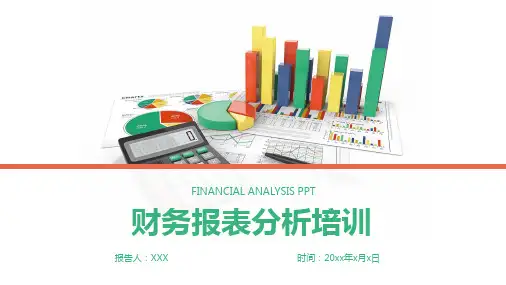
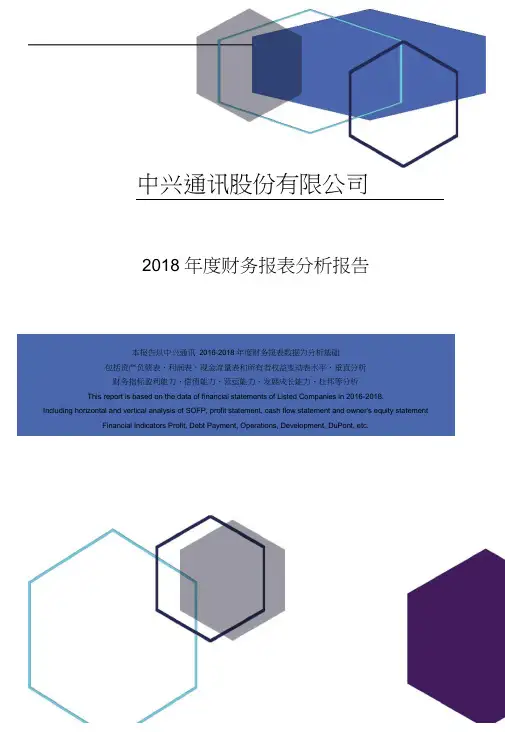
中兴通讯股份有限公司2018 年度财务报表分析报告1财务报表数据3.1.2 长期偿债能力分析 ....... (31)3.2营运能力分析 ......... (34)1.1资产负债表 .......... (1)3.2.1 流动资产周转分析 ....... .. (34)1.2利润表 ............... (4)3.2.2 固定资产周转分析 ....... .. (36)1.3现金流量表 .......... (5)3.2.3 总资产周转分析 ......... .. (37)1.4所有者权益变动表 ........................ (7)3.3盈利能力分析 ......... (37)2会计报表分析3.3.1 资产经营盈利能力分析 (37)2.1资产负债表分析 ....... . (8)3.3.2 资本经营盈利能力分析 (38)2.1.1 水平趋势分析 .......... .. (8)3.3.3 商品经营盈利能力分析 (40)2.1.2 垂直结构分析 .......... .. (14)3.3.4 盈利质量分析 ........... ......462.2利润表分析 .......... (18)3.4发展能力分析 ......... (47)2.2.1 水平趋势分析 .......... (18)3.4.1 资产资本成长分析 ....... .. (47)2.2.2 垂直结构分析 .......... .. (21)3.4.2 营业收益成长分析 ....... .. (48)2.3现金流量表分析 ....... (24)3.4.3 每股净资产分析 ......... .. (49)2.3.1 水平趋势分析 .......... .. (24)4杜邦分析2.3.2 垂直结构分析 .......... .. (26)4.1 杜邦分析表 ........... (50)2.4所有者权益变动表分析 . (27)4.2 杜邦分析图 ........... (50)2.4.1 水平趋势分析 .......... .. (27)5数据来源及计算说明2.4.2 垂直结构分析 .......... .. (28)5.1 数据来源 .............. .. 523财务指标分析5.2计算说明 .............. .. 523.1偿债能力分析 ......... .. (29)3.1.1 短期偿债能力分析 ...... .. (29)1.1 资产负债表表格 1 2016-2018 年度资产负债表中兴通讯股份有限公司,简称中兴通讯,所属的行业是通信传输设备,公司总部位于广东省。


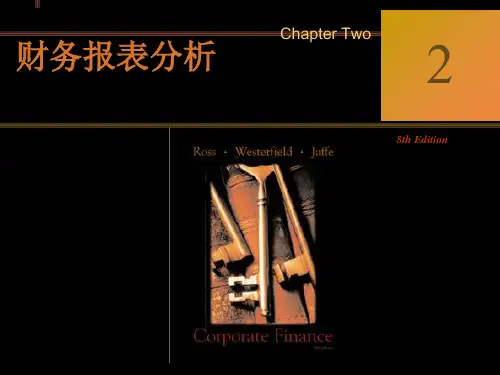


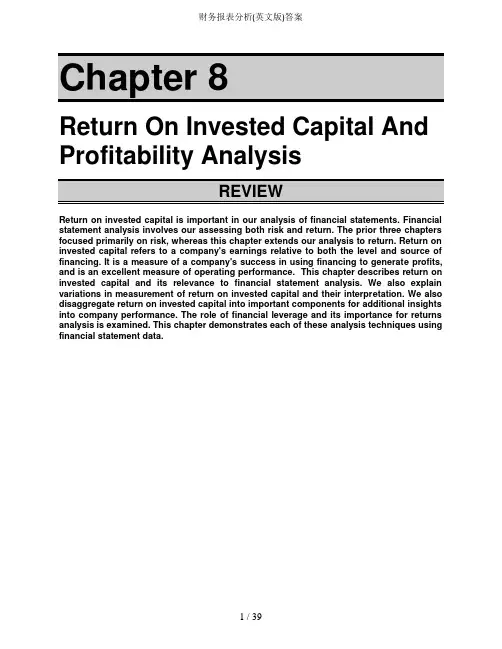
Chapter 8Return On Invested Capital And Profitability AnalysisReturn on invested capital is important in our analysis of financial statements. Financial statement analysis involves our assessing both risk and return. The prior three chapters focused primarily on risk, whereas this chapter extends our analysis to return. Return on invested capital refers to a company's earnings relative to both the level and source of financing. It is a measure of a company's success in using financing to generate profits, and is an excellent measure of operating performance. This chapter describes return on invested capital and its relevance to financial statement analysis. We also explain variations in measurement of return on invested capital and their interpretation. We also disaggregate return on invested capital into important components for additional insights into company performance. The role of financial leverage and its importance for returns analysis is examined. This chapter demonstrates each of these analysis techniques using financial statement data.•Importance of Return on Invested CapitalMeasuring Managerial EffectivenessMeasuring ProfitabilityMeasuring for Planning and Control •Components of Return on Invested CapitalDefining Invested CapitalAdjustments to Invested Capital and IncomeComputing Return on Invested Capital•Analyzing Return on Net Operating AssetsDisaggregating Return on Net Operating AssetsRelation between Profit Margin and Asset TurnoverProfit Margin AnalysisAsset Turnover Analysis•Analyzing Return on Common EquityDisaggregating Return on Common EquityFinancial Leverage and Return on Common EquityAssessing Growth in Common Equity•Describe the usefulness of return measures in financial statement analysis. •Explain return on invested capital and variations in its computation.•Analyze return on net operating assets and its relevance in our analysis. •Describe disaggregation of return on net operating assets and the importance of its components.•Describe the relation between profit margin and turnover.•Analyze return on common shareholders' equity and its role in our analysis. •Describe disaggregation of return on common shareholders' equity and the relevance of its components.•Explain financial leverage and how to assess a company's success in trading on the equity across financing sources.1. The return that is achieved in any one period on the invested capital of a companyconsists of the returns (and losses) realized by its various segments and divisions. In turn, these returns are made up of the results achieved by individual product lines and projects. A well-managed company exercises rigorous control over the returns achieved by each of its profit centers, and it rewards the managers on the basis of such results. Specifically, when evaluating new investments in assets or projects, management will compute the estimated returns it expects to achieve and use these estimates as a basis for its decision to invest or not.2. Profit generation is the first and foremost purpose of a company. The effectiveness ofoperating performance determines the ability of the company to survive financially, to attract suppliers of funds, and to reward them adequately. Return on invested capital is the prime measure of company performance. The analyst uses it as an indicator of managerial effectiveness, and/or a measure of the company's ability to earn a satisfactory return on investment.3. If the investment base is defined as comprising net operating assets, then netoperating profit (e.g., before interest) after tax (NOPAT) is the relevant income figure to use. The exclusion of interest from income deductions is due to its being regarded asa payment for the use of money from the suppliers of debt capital (in the same waythat dividends are regarded as a payment to suppliers of equity capital). NOPAT is the appropriate amount to measure against net operating assets as both are considered to be operating.4. First, the motivation for excluding nonproductive assets from invested capital isbased on the idea that management is not responsible for earning a return on non-operating invested capital. Second, the exclusion of intangible assets from the investment base is often due to skepticism regarding their value or their contribution to the earning power of the company. Under GAAP, intangibles are carried at cost.However, if their cost exceeds their future utility, they are written down (or there will be an uncertainty exception regarding their carrying value in the auditor's opinion).The exclusion of intangible assets from the asset base must be based on more substantial evidence than a mere lack of understanding of what these assets represent or an unsupported suspicion regarding their value. This implies that intangible assets should generally not be excluded from invested capital.5. The basic formula for computing the return on investment is net income divided bytotal invested capital. Whenever we modify the definition of the investment base by, say, omitting certain items (liabilities, idle assets, intangibles, etc.) we must also adjust the corresponding income figure to make it consistent with the modified asset base.6. The relation of net income to sales is a measure of operating performance (profitmargin). The relation of sales to total assets is a measure of asset utilization or turnover—a means of determining how effectively (in terms of sales generation) the assets are utilized. Both of these measures, profit margin as well as asset utilization,determine the return realized on a given investment base. Sales are an important factor in both of these performance measures.7. Profit margin, although important, is only one aspect of the return on invested capital.The other is asset turnover. Consequently, while Company B's profit margin is high, its asset turnover may have been sufficiently depressed so as to drag down the overall return on invested capital, leading to the shareholder's complaint.8. The asset turnover of Company X is 3. The profit margin of Company Y is 0.5%. Sinceboth companies are in the same industry, it is clear that Company X must concentrate on improving its asset turnover. On the other hand, Company Y must concentrate on improving its profit margin. More specific strategies depend on the product and industry.9. The sales to total assets (asset turnover) component of the return on invested capitalmeasure reflects the overall rate of asset utilization. It does not reflect the rate of utilization of individual asset categories that enter into the overall asset turnover. To better evaluate the reasons for the level of asset turnover or the reasons for changes in that level, it is helpful to compute the rate of individual asset turnovers that make up the overall turnover rate.10. The evaluation of return on invested capital involves many factors. Theinclusion/exclusion of extraordinary gains and losses, the use/nonuse of trends, the effect of acquisitions accounted for as poolings and their chance of recurrence, the effect of discontinued operations, and the possibility of averaging net income are justa few of many such factors. Moreover, the analyst must take into account the effectsof price-level changes on return calculations. It also is important that the analyst bear in mind that return on invested capital is most commonly based on book values from financial statements rather than on market values. And finally, many assets either do not appear in the financial statements or are significantly understated. Examples of such assets are intangibles such as patents, trademarks, research and development activities, advertising and training, and intellectual capital.11. The equity growth rate is calculated as follows:[Net income – Preferred dividends – Common dividend payout] / Average common equity.This is the growth rate due to the retention of earnings and assumes a constant dividend payout over time. It indicates the possibilities of earnings growth without resort to external financing. The resulting increase in equity can be expected to earn the rate of return that the company earns on its assets and, thus, further contribute to growth in earnings.12. a. The return on net operating assets and the return on common stockholders' equitydiffer by the capital investment base (and its corresponding effects on net income).RNOA reflects the return on the net operating assets of the company whereas ROCE reflects the perspective of common shareholders.b. ROCE can be disaggregated into the following components to facilitate analysis:ROCE = RNOA + Leverage x Spread. RNOA measures the return on net operating assets, a measure of operating performance. The second component (Leverage x Spread) measures the effects of financial leverage. ROCE is increased by adding financial leverage so long as RNOA>weighted average cost of capital. That is, if the firm can earn a return on operating assets that is greater than the cost of the capital used to finance the purchase of those assets, then shareholders are better off adding debt to increase operating assets.13. a. ROCE can be disaggregated as follows:equitycommon Av erage Sales Sales div idends Preferred - income Net ⨯ This shows that “equity turnover” (sales to average common equity) is one of the two components of the return on common shareholders' equity. Assuming a stable profit margin, the equity turnover can be used to determine the level and trend of ROCE. Specifically, an increase in equity turnover will produce an increase in ROCE if the profit margin is stable or declines less than the increase in equity turnover. For example, a common objective of discount stores is to lower prices by lowering profit margins, but to offset this by increasing equity turnover by more than the decrease in profit margin.b. Equity turnover can be rewritten as follows:equitycommon Av erage assets operating Net assets operating Net Sales ⨯ The first factor reflects how well net operating assets are being utilized. If the ratio is increasing, this can signal either a technological advantage or under-capacity and the need for expansion. The second factor reflects the use of leverage. Leverage will be higher for those firms that have financed more of their assets through debt. By considering these factors that comprise equity turnover, it is apparent that EPS cannot grow indefinitely from an increase in these factors. This is because these factors cannot grow indefinitely. Even if there is a technological advantage in production, the sales to net operating assets ratio cannot increase indefinitely. This is because sooner or later the firm must expand its net operating asset base to meet rising sales or else not meet sales and lose a share of the market. Also, financing new assets with debt can increase the net operating assets to common equity ratio. However, this can only be pursued to a point —at which time the equity base must expand (which decreases the ratio).14. When convertible debt sells at a substantial premium above par and is clearly held byinvestors for its conversion feature, there is justification for treating it as the equivalent of equity capital. This is particularly true when the company can choose at any time to force conversion of the debt by calling it in.Exercise 8-1 (35 minutes)a. First alternative:NOPAT = $6,000,000 * 10% = $600,000Net income = $600,000 – [$1,000,000*12%](1-.40) = $528,000Second alternative:NOPAT = $6,000,000 * 10% = $600,000Net income = $600,000 – [$2,000,000*12%](1-.40) = $456,000b. First alternative:ROCE = $528,000 / $5,000,000 = 10.56%Second alternative:ROCE = $456,000 / $4,000,000 = 11.40%c. First alternative:Assets-to-Equity = $6,000,000 / $5,000,000 = 1.2Second alternative:Assets-to-Equity = $6,000,000 / $4,000,000 = 1.5d. First, let’s compute return on assets (R NOA):First alternative: $600,000 / $6,000,000 = 10%Second alternative: $600,000 / $6,000,000 = 10%Second, notice that the interest rate is 12% on the debt (bonds). More importantly, the after-tax interest rate is 7.2% (12% x (1-0.40)), which is less than RNOA. Hence, the company earns more on its assets than it pays for debt on an after-tax basis. That is, it can successfully trade on the equity—use bondholders’ funds to earn additional profits.Finally, since the second alternative uses more debt, as reflected in the assets-to-equity ratio in c, the second alternative is probably preferred. The shareholders would take on additional risk with the second alternative, but the expected returns are greater as evidenced from computations in b.Exercise 8-2 (40 minutes)a. NOPAT = Net income = $10,000,000 x 10% = $1,000,000b. First alternative:NOPAT = $1,000,000 + $6,000,000*10% = $1,600,000Net income = $1,600,000 – ($2,000,000 ⨯ 5% x [1-.40]) = $1,540,000Second alternative:NOPAT = $1,000,000 + $6,000,000*10% = $1,600,000Net income = $1,600,000 – ($6,000,000 ⨯ 6% x [1-.40]) = $1,384,000c. First alternative: ROCE = $1,540,000 / ($10,000,000 + $4,000,000) = 11%Second alternative: ROCE = $1,384,000 / ($10,000,000 + $0) = 13.84%d. ROCE is higher under the second alternative due to successful use ofleverage—that is, successfully trading on the equity. [Note: Asset-to-Equity is1.14=$16 mil./$14 mil. (1.60=$16 mil./$10 mil.) under the first (second)alternative.] The company should pursue the second alternative in the interest of shareholders (assuming projected returns are consistent with current performance levels).a. RNOA = 2 x 5% = 10%b. ROCE = 10% + 1.786 x 4.4% = 17.86%c. RNOA 10.00%Leverage advantage 7.86%Return on equity 17.86%Exercise 8-4 (30 minutes)a. Computation and Interpretation of ROCE:Year 5 Year 9Pre-tax profit margin .......................................................... 0.112 0.109 Asset turnover .................................................................... 0.46 0.44 Assets-to-equity ................................................................. 3.25 3.40 After-tax income retention * .............................................. 0.570 0.556 ROCE (product of above) .................................................. 9.54% 9.07% * 1-Tax rate.ROCE declines from Year 5 to Year 9 because: (1) pre-tax margin decreases by approximately 3%, (2) asset turnover declines by roughly 4.3%, and (3) the tax rate increases by about 3.8%. The combination of these factors drives the decline in ROCE—this is despite the slight improvement in the assets-to-equity ratio.b. The main reason EPS increases is that shareholders had a large amount ofassets and equity working for them. Namely, the company grew while return on assets and return on equity remained fairly stable. In addition, the amount of preferred stock declined, as did the amount of preferred dividends. With this decline in the cost of carrying preferred stock, earnings available to common stock increased.(CFA Adapted)a. RNOA = 3 x 7% = 21%b. ROCE = RNOA + LEV x Spread = 21% + (1.667 x 8.4%) = 35%c. Net leverage advantage to common equityReturn on net operating assets .................................. 21%Leverage advantage .................................................... 14%Return on common equity (rounding difference) ..... 35%Exercise 8-6 (30 minutes)a. At the present level of debt, ROCE = $157,500 / $1,125,000 = 14%.In the absence of leverage, the noncurrent liabilities would be substituted with equity. Accordingly, there would be no interest expense with all-equityROCE without leverage = $184,500 / $1,800,000 = 10.25%.14% with leverage but only 10.25% without leverage.b. NOPAT = $157,500 + [$675,000 x 8% x (1-.50)] = $184,500RNOA = $184,500 / ($2,000,000-$200,000) = 10.25%c. The company is utilizing borrowed funds in its capital structure. Since theROCE is greater than RNOA, the use of financial leverage is beneficial to stockholders. Specifically, the after cost of debt is 4% and the financial leverage (NFO/Equity) is $675,000 / $1,125,000 = 60%. Therefore,ROCE = RNOA + LEV x Spread = 10.25% + 0.60 x (10.25% - 4%) = 14%, as before. The favorable effect of financial leverage is given by the term [0.60 x (10.25% - 4%)] = 3.75%.1. c2. a3. cExercise 8-8 (20 minutes)(Assessments of profit margin and asset turnover are relative to industry norms.)a. Higher profit margin and lower asset turnover.b. Higher asset turnover and lower profit margin.c. Higher profit margin and similar/lower asset turnover.d. Higher asset turnover and similar/lower profit margin.e. Higher asset turnover and lower/similar profit margin.f. Higher asset turnover and similar/higher profit margin.g. Higher asset turnover and lower profit margin.Exercise 8-9 (20 minutes)The memorandum to Reliable Auto Sales President would include the following points:•Both Reliable and Legend Auto Sales are perpetually investing $100,000 in automobile inventory.•Legend Auto Sales is able to generate more profit than Reliable because it is turning over its inventory (10 cars) more often. Specifically, Legend is turning its inventory over 10 times per year while Reliable is turning its inventory over only 5 times per year. Hence, given the same investment in automobile inventory, Legend is twice as profitable as Reliable.•Encourage Reliable to sacrifice some return on each sale to increase the inventory turnover. By slightly reducing price, relative to that charged by Legend, Reliable predictably will find that overall profitability increases. This is because while profit per sale declines, the number of units sold and, therefore, inventory turnover will increase. These factors predictably yield increased return on assets.Computation of Asset (PP&E) Turnover [computed as Sales / PP&E (net)]: Northern: $12,000 / $20,000 = 0.60Southern: $6,000 / $20,000 = 0.30This implies that Northern generates $0.60 in sales per year for each $1 investment in PP&E. In contrast, Southern generates $0.30 in sales per year for each $1 investment in PP&E. This shows that Northern is able to generate twice the return for each $1 invested in PP&E. Assuming equal profit margins, Northern will report a higher return on assets because of the volume of sales that the company is able to generate with its investment in PP&E (at least in the short run).Exercise 8-11 (15 minutes)Low volume operations mean that fixed costs, which in the case of automakers are substantial, must be absorbed by a low number of units produced. Since the lower of cost or market rule implies that inventory cannot be priced higher than expected sales price less costs of disposal plus a normal profit margin, much of that excess cost must be charged to the period incurred. In this case, that means the fourth quarter financial statements absorb much of this cost. This is probably the most likely accounting-based reason for the fourth quarter losses described in the news release.Problem 8-1 (30 minutes)a. 1. Quaker Oats does not reveal its computation of this return. Accordingly, wemake some simple computations and assumptions: (i) For simplicity, focus on one share, (ii) The dividend is $1.56 for Year 11, (iii) The average stock price is $55 and the price increase for Year 11 is $14—based on the beginning price of $48 and the ending price of $62. Using this information, we compute return to a share of stock as follows:= [Dividend per share + Price increase per share] / Average price per share = [$1.56 + $14] / $55= 28.3%However, if we use the beginning price of $48 per share, we get closer to the company's 34% return:= [$1.56 + $14] / $48= 32.4%2. The return on common equity is based on the relation between net incomeand the book value of the equity capital. In contrast, Quaker Oats’ “return t o shareholders” uses dividends plus market value change in relation to the market price per share (cost of investment to shareholders.)b. The company must have derived the 3.6% from price, market, and otherfactors that are not disclosed. Conceptually, this 3.6% should reflect the added risk of an investment in Quaker Oats’ stock vis-à-vis a risk-free security such as a U.S. Treasury bond.c. Quaker does not reveal its computations. It may disclose a variety of interestrates on long-term debt that it carries in the notes to financial statements.Based on data available to it, but not to the financial statement reader, it probably computed a weighted-average interest rate from which it deducted the tax benefit in arriving at the 6.4% cost of debt.a. Computation of Return on Invested Capital Measures:As a first step, we construct the company’s income statement.Sales (500,000 units @ $10). ................................................ $5,000,000 Fixed costs ....................................................................... 1,500,000 Variable costs (500,000 units @ $4). ............................. 2,000,000 Labor costs (20 employees x $35,000). ......................... 700,000 Income before taxes .......................................................... 800,000 Taxes (50% rate) ................................................................. 400,000 Net income .......................................................................... $ 400,000(1) RNOA = [$400,000 + ($2,000,000 x 7.5%)(1-0.50)] / ($8,000,000-$2,00,000)= $475,000 / $6,000,000 = 7.92%(2) ROCE = [$400,000 - ($1,000,000 x 6%)] / $3,000,000 = 11.33%Fixed costs ($1,500,000 x 1.06) ......................................................... 1,590,000 Variable costs ($550,000 units @ $4) .............................................. 2,200,000 Income before labor costs and taxes ............................................. $1,710,000 To obtain a 10% return on long-term debt and equity capital, Zear will need a numerator of $600,000 given an invested capital base of $6,000,000. The required operating income to yield this $600,000 amount is computed as: Net income + Interest expense x (1 - 0.50) = $600,000Net income + ($2,000,000 x 7.5%) x (1-0.50) = $600,000Net income = $525,000Assuming taxes at a 50% rate, Zear needs pre-tax income of $1,050,000, computed as:Income before labor and taxes ............ $1,710,000Labor costs ........................................... ?Pre-tax income ...................................... $1,050,000This implies:Labor costs = $660,000 orAverage wage per worker = $660,000 / 22 employees = $30,000 per employee Since the current salary level is $35,000, Zear cannot achieve its target return level and give a salary raise to its employees.(CFA Adapted)a. ROCE = $1,650 / $3,860 = 42.7%b. NOPAT = ($2,550 + $10) x (1-0.35) = $1,664NOA = $7,250-$3,290 = $3,960RNOA (using year-end NOA balance) = $1,664 / $3,960 = 42%The effect of financial leverage, thus, is only 0.7% as NFO/NFE are insignificant. Most of Merck’s ROCE in this year is derived from operating results.Pre-tax income to sales 0.36Net income to sales 0.23Sales/current assets 1.47Sales / fixed assets 2.97Sales / total assets 0.98Total liabilities / equity 0.88L-T liabilities / equity 0.03a. 1. RNOA = NOPATAvg. NOANOPAT = [$186,000 + $2,000 - $120,000 - $37,000 + $1,000] x 50% = $16,000 Note: we include income from equity investments under the assumptions that these are operating rather than financial investments. We also include the cumulative effect as operating in the absence of information to the contrary. Minority interest and discontinued operations are nonoperating (minority interest is therefore, treated as equity in the ROCE computation).NOA Year 6 = $138,000 - $29,000 - $7000 - $3,600 = $98,400 NOA Year 5 = $105,000 - $23,000 - $2,000 - $2,000 = $78,000RNOA = $16,000 / ([$98,400 + $78,000]/2) = 18.14%2. ROCE = Net income - Preferred dividendsAverage common equityROCE = ($10,000 –$0) /[($55,400* + $47,800*)/2] = 19.38% *Note: minority interest is treated as equity. If Minority interest is ignored, the ROCE is 19.8%b. NFO = NOA - EquityYear 6: $43,000; Year 5: $30,200LEV = Avg. NFO / Ave Equity = ([$43,000 + $30,200] / 2) / ([$55,400* + $47,800*] /2)= 0.71NFE = NOPAT – Net incomeYear 6: $6,000NFR = NFE / Avg. NFO = $6,000 / ([$43,000 + $30,200] / 2) = 16.4%Spread = RNOA – NFR = 18.14% - 16.4% = 1.74%ROCE = RNOA + LEV x Spread = 18.14 + 0.71 x 1.74% = 19.38%94% (18.14%/19.38%) of Zeta’s ROCE is derived for m operating activities. The company is effectively using leverage, however, as indicated by the positive spread, but the leverage does not contribute significantly to Zeta’s return on equity and may not be worth the added risk.a. ROCE = [Net income –preferred dividends] / stockholders’ equity**end of year in this problemROCE Year 5: [$14 – $0] / $125 = 11.2%ROCE Year 9: [$34 - $0] / $220 = 15.5%RNOA Year 5 = ($35 x 0.50) / ($52 + $123) = 10.0%RNOA Year 9 = ($68 x 0.50) / ($63 + $157) = 15.5%ROCE = RNOA + Leverage x SpreadYear 5: 10.0% + 1.2% = 11.2%Year 9: 15.5% + 0 = 15.5%b. Texas Talcom’s ROCE has increased form years 5 to 9. The source is thisincrease, however, has been an increase in RNOA as the leverage effect is zero in Year 9 since its long-term debt has been retired. Given the RNOA increase, additional leverage might be explored as a way to increase shareholder returns.Selling price per unit ...................... $6.00 $5.00 $50.00 $50.00 Unit cost ........................................... $5.00 $4.00 $32.50 $30.00Analysis of Variation in Product A SalesIncreased quantity at Yr 6 prices (3,000 x $5) ........................ $ 15,000 Price increase at Yr 6 quantity (7,000 x $1) ........................... 7,000 Quantity increase x price increase (3,000 x $1) .................... 3,000 Analysis of Variation in Product A Cost of SalesIncreased quantity at Yr 6 cost (3,000 x $4) ........................... (12,000) Increased cost at Yr 6 quantity (7,000 x $1) ........................... (7,000) Cost increase x quantity increase (3,000 x $1) ...................... (3,000) Net Variation (Increase) in Gross Margin for Product A ............. $ 3,000Analysis of Variation in Product B SalesDecreased quantity at Yr 6 prices (300 x $50) ....................... $ (15,000) Analysis of Variation in Product B Cost of Sales:Decreased quantity at Yr 6 cost (300 x $30) .......................... 9,000 Increased cost at Yr 6 quantity (900 x $2.50) ......................... (2,250) Cost increase x quantity decrease (300 x $2.50) . (750)Net Variation (Decrease) in Gross Margin for Product B ............ $ (7,500)Summary of Net Variation in Margins for Products A and BNet increase from product A ......................................................... $ 3,000 Net decrease from product B ........................................................ (7,500) Net Decrease in Gross Margin ...................................................... $ (4,500)a.SPYRES MANUFACTURING COMPANYComparative Common-Size Income StatementsYear Ended December 31 IncreaseYear 9 Year 8(Decrease)Net sales ............................. 100.0% 100.0% 20.0% Cost of goods sold ............ 81.7 86.0 14.0 Gross margin on sales ...... 18.3 14.0 57.1 Operating expenses .......... 16.8 10.2 98.0 Income before taxes .......... 1.5 3.8 (52.6) Income taxes ...................... 0.4 1.0 (52.0) Net income ......................... 1.1 2.8 (52.9)b. Performance in Year 9 is poor when compared with Year 8. One bright spot isthe percentage of Cost of Goods Sold to Sales, which decreased in Year 9.However, Operating Expenses climbed sharply. This sharp climb in operating expenses is unexpected since there is usually a larger fixed cost component comprising these costs compared with that for Cost of Goods Sold.Management should further check operating expenses. If operating expenses had remained at the Year 8 level of 10.2%, income would have been up favorably for Year 9. Operating expenses may have included a future-directed component such as advertising or training costs. Also, management would want to follow up on the change in gross margin. The sharp improvement in gross margin may have been due to factors such as the liquidation LIFO inventory layers or, alternatively, to something more fundamental with the activities of the firm.。